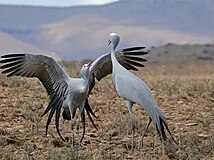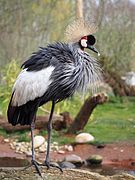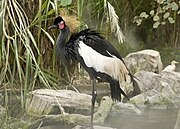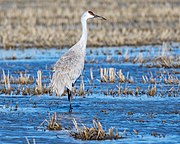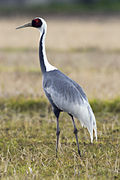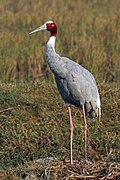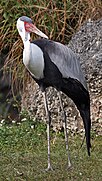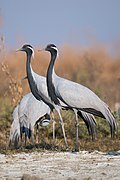List of cranes
Cranes are threatened by
There are currently 15 extant species of crane recognised by the International Ornithologists' Union distributed among four genera.[7] The cranes are most closely related to the family Aramidae, which contains a single extant species, the limpkin.[1][8] These two families, together with the trumpeters, rails, and finfoots, comprise the order Gruiformes.[7] Many species of fossil cranes are known from the Eocene onwards; however, their exact number and taxonomy are unsettled due to ongoing discoveries.[9]
Conventions
| Critically Endangered (1 species) | |
| EN | Endangered (2 species) |
|---|---|
| VU | Vulnerable (7 species) |
| NT | Near threatened (1 species) |
| LC | Least concern (4 species) |
Conservation status codes listed follow the
This list follows the taxonomic treatment (designation and order of species) and nomenclature (scientific and common names) of version 13.2 of the IOC World Bird List.[7] Where the taxonomy proposed by the IOC World Bird List conflicts with the taxonomy followed by the IUCN[a] or the 2023 edition of The Clements Checklist of Birds of the World, the disagreement is noted next to the species's common name (for nomenclatural disagreements) or scientific name (for taxonomic disagreements).
Classification
The
| |||||||||||||||||||||||||||||||||||||||||||||||||||||||||||||||||||||||||||||||||||||||
| Cladogram depicting relationships among the cranes, based on a 2021 study of genetic and behavioural data.[11] |
Gruids
| Common name | Scientific name and subspecies | Range | IUCN status and estimated population |
|---|---|---|---|
| Grey crowned crane | B. regulorum (Bennett, 1834) Two subspecies
|
Eastern and southeastern Africa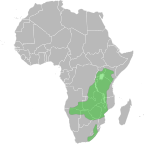
|
EN
|
| Black crowned crane | B. pavonina Linnaeus, 1758 Two subspecies
|
Northern, central, and western Africa
|
VU
|
| Common name | Scientific name and subspecies | Range | IUCN status and estimated population |
|---|---|---|---|
| Siberian crane | L. leucogeranus (Pallas, 1773) |
Northwestern Palearctic and east-central Siberia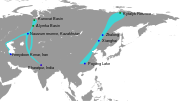
|
CR
|
| Common name | Scientific name and subspecies | Range | IUCN status and estimated population |
|---|---|---|---|
| Sandhill crane | A. canadensis ( Linnaeus , 1758))
Five subspecies
|
North America
|
LC
|
| White-naped crane | A. vipio (Pallas, 1811) |
Southeastern Siberia, northeastern Mongolia and northeastern China
|
VU
|
| Sarus crane | A. antigone (Linnaeus, 1758) Three subspecies
|
Northern India, Southeast Asia, and northern Australia
|
VU
|
| Brolga | A. rubicunda (Perry, 1810) |
Australia and south-central New Guinea
|
LC
|
| Common name | Scientific name and subspecies | Range | IUCN status and estimated population |
|---|---|---|---|
| Wattled crane | G. carunculata[b] (Gmelin, J. F., 1789) |
Southern and eastern Africa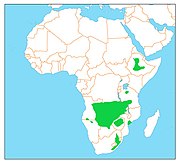
|
VU
|
| Blue crane | G. paradisea[c] (Lichtenstein, A. A. H., 1793) |
Southern Africa
|
VU
|
| Demoiselle crane | G. virgo[d] (Linnaeus, 1758) |
Asia and northwestern Africa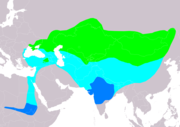
|
LC
|
| Red-crowned crane | G. japonensis (Müller, P. L. S., 1776) |
East Asia and Siberia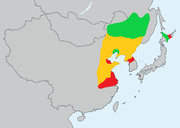
|
VU
|
| Whooping crane | G. americana (Linnaeus, 1758) |
North America
|
EN
|
| Common crane | G. grus (Linnaeus, 1758) |
Afro-Eurasia
|
LC
|
| Hooded crane | G. monacha Temminck, 1835 |

|
VU
|
| Black-necked crane | G. nigricollis Przevalski, 1876 |
India and China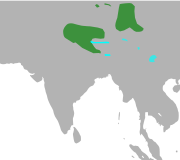
|
NT
|
Notes
- ^ The IUCN follows the taxonomy proposed by the HBW and BirdLife Taxonomic Checklist.[10]
- ^ The wattled crane is placed in the genus Bugeranus by the IUCN and Clements Checklist.[10][17]
- ^ The blue crane is placed in the genus Anthropoides by the IUCN and Clements Checklist.[10][17]
- ^ The Demoiselle crane is placed in the genus Anthropoides by the IUCN and Clements Checklist.[10][17]
References
- ^ from the original on 1 September 2023. Retrieved 1 September 2023.
- ^ ISBN 978-1-4081-6265-1. Archivedfrom the original on 19 September 2023. Retrieved 15 September 2023.
- ISBN 9781400874163.
Herons usually fly with their necks retracted (coiled, unlike ibis, storks, and cranes) but occasionally extend their necks during shorter flights.
- ^ . Retrieved 11 November 2021.
- ^ . Retrieved 13 November 2021.
- ^ . Retrieved 3 January 2023.
- ^ a b c d Gill, F.; Donsker, D.; Rasmussen, P., eds. (July 2023). "Finfoots, flufftails, rails, trumpeters, cranes, limpkin". IOC World Bird List. v 13.2. Archived from the original on 24 April 2020. Retrieved 31 August 2023.
- from the original on 1 September 2023. Retrieved 1 September 2023.
- ^ "Fossilworks: Gruidae". Paleobiology Database. University of Wisconsin–Madison. Archived from the original on 18 May 2022. Retrieved 1 September 2023.
- ^ a b c d "Handbook of the Birds of the World and BirdLife International digital checklist of the birds of the world. Version 7". HBW and BirdLife International. 2022. Archived from the original on 25 September 2019. Retrieved 1 July 2023.
- ^ ISSN 2053-7166.
- . Retrieved 19 November 2021.
- . Retrieved 18 November 2021.
- . Retrieved 20 February 2022.
- . Retrieved 20 February 2022.
- . Retrieved 20 February 2022.
- ^ a b c Clements, James F.; Rasmussen, P. C.; Schulenberg, T. S.; Iliff, M. J.; Fredericks, T. A.; Gerbracht, J. A.; Lepage, Denis; Billerman, S. M.; Sullivan, B. L.; Wood, C. L. (2023). "The eBird/Clements checklist of Birds of the World: v2023". Clements Checklist. Archived from the original on 1 January 2020. Retrieved 30 October 2023.
- . Retrieved 20 February 2022.
- . Retrieved 20 February 2022.
- . Retrieved 14 February 2022.
- ^ BirdLife International (2022). "Grus japonensis". IUCN Red List of Threatened Species. 2021: e.T22692167A213488064. Retrieved 31 August 2023.
- . Retrieved 19 February 2022.
- . Retrieved 18 November 2021.
- . Retrieved 19 November 2021.

